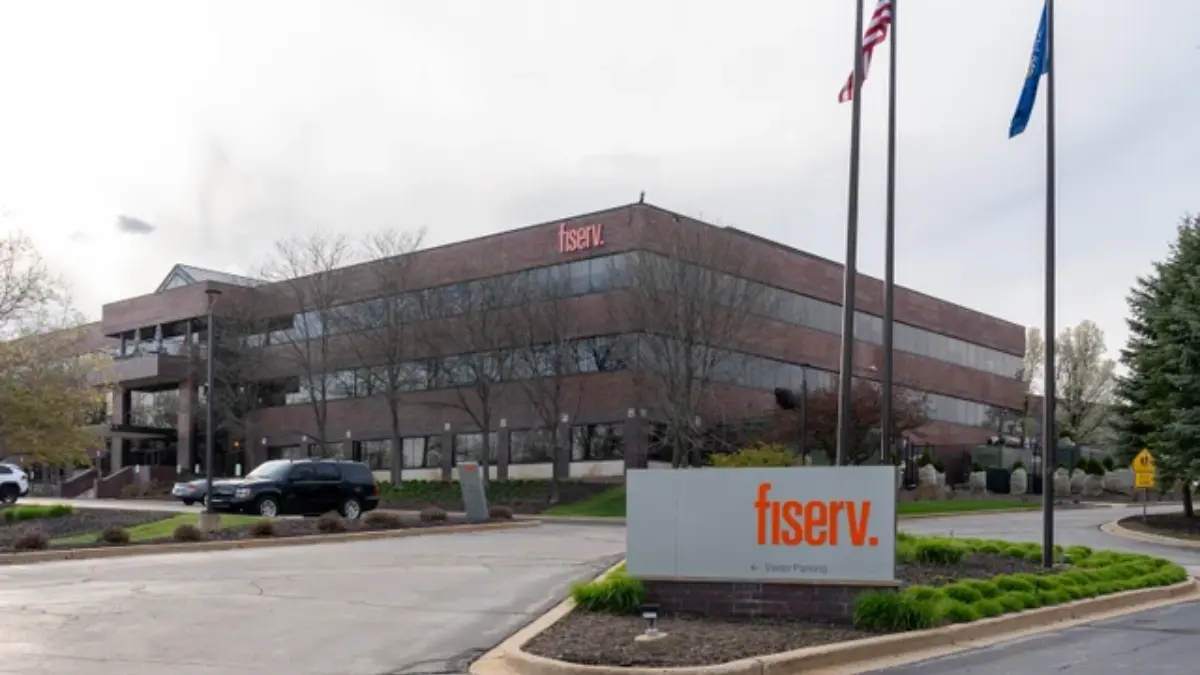Fiserv Q3 earnings miss sends shockwaves through Wall Street as the fintech giant slashes earnings guidance, revamps leadership, and launches its “One Fiserv” action plan to restore investor confidence and accelerate growth.
Fiserv Q3 Earnings Miss: Leadership Shake-Up and Strategic Reset After 30% Stock Plunge

The Fiserv Q3 earnings miss has stunned Wall Street and the fintech industry alike. The payment technology company’s disappointing third-quarter performance triggered a massive 30% plunge in Fiserv’s stock, prompting immediate leadership changes, board restructuring, and a sweeping strategic overhaul.
Fiserv’s move underscores the challenges facing global fintech players amid tightening margins, slowing growth, and rising competition in digital payments. Despite strong assets like its Clover small business platform, Fiserv’s latest financials reveal deep issues that demand urgent attention.
Overview: Fiserv Q3 Earnings Miss and Market Reaction
On October 29, 2025, Fiserv (FI) reported Q3 adjusted EPS of $2.04, well below Wall Street’s consensus estimate of $2.65. This shortfall marks one of the company’s weakest quarters in years, driving its shares down by 30% in early trading.
The Fiserv Q3 earnings miss wasn’t just a numbers issue—it was a signal to investors that growth has stalled across critical business units, particularly in Financial Solutions.
The company responded swiftly by refreshing its leadership team, introducing a new board structure, and unveiling its “One Fiserv” action plan—a blueprint to restore growth and investor confidence.
| Financial Metric (Q3 2025) | Reported | Wall Street Consensus | Prior Quarter (Q2 2025) |
|---|---|---|---|
| Adjusted EPS | $2.04 | $2.65 | $2.47 |
| Adjusted Revenue | $4.92B | $5.35B | $5.20B |
| Organic Revenue Growth | 3.5%–4% (revised) | ~10% (prior expectation) | 8% |
| Operating Margin | 37.0% | N/A | 39.6% |
| Stock Performance (Post-Earnings) | -30% | — | — |
This table shows how deeply the Fiserv Q3 earnings miss deviated from expectations—leading to swift executive actions.
Leadership Changes After the Fiserv Q3 Earnings Miss
In the wake of the Fiserv Q3 earnings miss, the company announced a significant leadership reshuffle aimed at driving transformation and strengthening execution.
- Takis Georgakopoulos and Dhivya Suryadevara were named co-presidents, effective December 1, 2025.
- Paul Todd, former CFO at Global Payments, was appointed chief financial officer, succeeding Robert Hau, who will transition to a senior advisory role through Q1 2026.
- On the board, Gordon Nixon, Céline Dufétel, and Gary Shedlin will join as directors effective January 1, 2026, with Nixon taking over as independent chairman.
This comprehensive management restructuring signals a renewed focus on accountability, operational efficiency, and client-first leadership.
CEO Mike Lyons stated,
“Our current performance is not where we want it to be nor where our stakeholders expect it to be. As the world’s largest fintech, Fiserv has the size, scale, and suite of innovative products to capitalize on the rapidly evolving finance and commerce landscape.”
His comments reinforced the company’s commitment to bounce back from the Fiserv Q3 earnings miss through strategic recalibration and innovation.
One Fiserv Action Plan: A Blueprint for Recovery
The One Fiserv action plan was launched to rebuild investor trust and accelerate growth across five key pillars.
| One Fiserv Pillars | Strategic Focus |
|---|---|
| Client-First Mindset | Deepen enterprise relationships and expand revenue per client. |
| Small Business Growth via Clover | Strengthen the Clover ecosystem as a small business operating platform. |
| Innovation in Finance and Commerce | Build differentiated platforms with embedded finance and stablecoin initiatives. |
| Operational Excellence through AI | Optimize internal processes and customer experiences using artificial intelligence. |
| Disciplined Capital Allocation | Focus on long-term value creation and financial discipline. |
This strategy aims to turn the Fiserv Q3 earnings miss into a catalyst for transformation, aligning operational goals with shareholder expectations.
Financial Breakdown: Weak Quarter Across Key Segments
The Fiserv Q3 earnings miss was driven by widespread softness across its primary segments—Merchant Solutions and Financial Solutions.
- Merchant Solutions organic revenue rose 5% year-over-year, but fell short of historical growth trends.
- Financial Solutions revenue declined 3%, dragging overall performance.
- Total organic revenue growth slowed to just 1%, down sharply from 8% in Q2.
- The adjusted operating margin dropped to 37%, compared with 40.2% a year ago.
| Segment | Q3 2025 Revenue | Y/Y Change | Operating Margin |
|---|---|---|---|
| Merchant Solutions | $2.60B | +5% | 37.2% |
| Financial Solutions | $2.33B | -3% | 42.5% |
| Total | $4.93B | +1% | 37.0% |
This detailed breakdown highlights the core pressure points behind the Fiserv Q3 earnings miss, particularly in legacy financial services operations.
Nasdaq Listing and Strategic Positioning
In addition to the financial turbulence, Fiserv announced it would transfer its Class A common stock listing to Nasdaq from the New York Stock Exchange (NYSE), effective November 11, 2025.
The move, under the original ticker “FISV”, signals an effort to align more closely with the tech-oriented ecosystem Nasdaq offers. Analysts view this as a symbolic step to emphasize Fiserv’s fintech identity rather than traditional banking roots.
While this won’t immediately offset the impact of the Fiserv Q3 earnings miss, it reflects a strategic rebranding consistent with the company’s ambition to innovate through AI, embedded finance, and stablecoin technology.
Investor Confidence and Market Implications
The Fiserv Q3 earnings miss and subsequent stock plunge rattled investors but also drew attention to the company’s long-term prospects. Despite the short-term setback, several analysts believe that Fiserv’s One Fiserv action plan could unlock value over time if executed effectively.
Key investor concerns include:
- Earnings Reliability: How quickly Fiserv can stabilize EPS growth after the guidance cut.
- Operational Efficiency: Whether AI-driven efficiencies can offset declining margins.
- Innovation Execution: Success in delivering new platforms in embedded finance and commerce.
- Leadership Transition: Smooth integration of new executives into the existing management framework.
If these challenges are managed effectively, Fiserv could recover from its Q3 earnings miss and reclaim investor trust heading into 2026.
Analyst Perspectives on Fiserv’s Future
Market analysts have mixed reactions to the Fiserv Q3 earnings miss. Some see it as a wake-up call, while others view it as a short-term hiccup in a long-term growth narrative.
Bullish analysts emphasize Fiserv’s strengths:
- Strong presence in digital payments via Clover.
- Growing merchant solutions network.
- Long-term potential in AI-driven operations.
Bearish analysts, however, highlight:
- Weak organic revenue growth.
- Reduced profit margins.
- Slow progress in innovation relative to fintech competitors like PayPal and Block.
Still, the Fiserv Q3 earnings miss has prompted a reset that could make the company more resilient in the coming quarters.
The Broader Fintech Context
Fiserv’s struggles mirror broader headwinds in the fintech industry—from margin pressures to slower transaction growth. As global payments evolve toward embedded finance, stablecoin integration, and AI automation, traditional players like Fiserv must pivot quickly to remain competitive.
The Fiserv Q3 earnings miss serves as a reminder that even top-tier fintech firms face disruption risk if they fail to adapt to changing consumer and enterprise dynamics.
FAQs About the Fiserv Q3 Earnings Miss
1. Why did Fiserv’s stock drop 30%?
The sharp decline followed the Fiserv Q3 earnings miss, weaker-than-expected EPS, and a reduced earnings forecast for 2025.
2. What caused the Q3 earnings miss?
Lower-than-expected revenue in Financial Solutions and slower organic growth contributed to the miss, alongside higher operational costs.
3. What is the “One Fiserv” action plan?
It’s Fiserv’s five-pillar recovery framework focusing on client-first operations, innovation, AI-driven efficiency, and disciplined capital allocation.
4. Who are the new leaders at Fiserv?
Takis Georgakopoulos and Dhivya Suryadevara were named co-presidents, and Paul Todd was appointed CFO. New board members will join in 2026.
5. Why is Fiserv moving its listing to Nasdaq?
The move underscores Fiserv’s transformation into a fintech-focused company aligned with technology-driven peers.
Conclusion: Turning a Setback into a Strategy
The Fiserv Q3 earnings miss marks a pivotal moment in the company’s trajectory. While the 30% stock plunge reflects investor frustration, the swift leadership changes and One Fiserv action plan demonstrate proactive management intent on driving recovery.
By emphasizing AI innovation, client-first strategies, and embedded finance, Fiserv aims to transform short-term disappointment into long-term opportunity.
If the company can deliver on its promises, the Fiserv Q3 earnings miss could ultimately become the turning point that redefines its future in the global fintech landscape.

